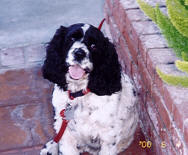Introduction
When teaching
the "stay"
Instruction, the first step is to
find the pet in a situation where he or she is already relaxed and
in a sit or down position. In a calm voice, say, "Good stay." This
praises the dog for what he or she is already doing, while at the
same time introducing the "stay"
Instruction. If the dog starts to
get up and come to you because you are paying attention to him or
her, go over to the dog and gently put him or her back into the
original position, and say, "Stay. Good dog." Then, say, "Okay"
while clapping and moving away from the dog so that the dog also
moves.
|
Asking the dog to stay is
like asking the dog to
"freeze" in an exact
position (sit or down) until
you ask the dog to change
positions or release the dog
to move freely. |
 Hand
signals
Hand
signals
Your dog will often learn a hand
signal before learning a verbal cue. The simplest
"stay"
is taught from the sit position.
When your dog will sit reliably when requested you
can begin teaching, "stay."
After giving the "sit"
Instruction, face your palm at the
dog in a vertical position a few inches from the
dog's nose and say,
"Stay."
If the dog moves...
If the dog gets up and moves, quickly
approach the dog and ask for a "sit", repeat the word, "stay" and say, "good stay." Do NOT scold the
dog. Repeat the "Stay"
Instruction. Start with a one second
"stay." Give the food treat
while the dog is staying.
Say, "good" as you give the
treat. THEN, release the dog
from the stay. As the dog learns
the word, work on attention span
and ability to stay by asking
for a few seconds more. Extend
the time gradually up to one
minute. Do NOT move away from
the dog. If the dog looks like
he or she is even thinking about
moving, repeat the "sit" and
"stay" to remind the dog the
exercise is not done. Eventually
begin to work in a slow circle
around your dog returning to the
front BEFORE your dog breaks the
"stay". When you can walk
all the way around your dog and
your dog can stay in one
position, while remaining
focused on you for several
minutes you may begin to work
way further away from your dog.
Always stop on a good note! Go
at your dog's individual pace to
keep the exercise positive and
successful.
word, "stay" and say, "good stay." Do NOT scold the
dog. Repeat the "Stay"
Instruction. Start with a one second
"stay." Give the food treat
while the dog is staying.
Say, "good" as you give the
treat. THEN, release the dog
from the stay. As the dog learns
the word, work on attention span
and ability to stay by asking
for a few seconds more. Extend
the time gradually up to one
minute. Do NOT move away from
the dog. If the dog looks like
he or she is even thinking about
moving, repeat the "sit" and
"stay" to remind the dog the
exercise is not done. Eventually
begin to work in a slow circle
around your dog returning to the
front BEFORE your dog breaks the
"stay". When you can walk
all the way around your dog and
your dog can stay in one
position, while remaining
focused on you for several
minutes you may begin to work
way further away from your dog.
Always stop on a good note! Go
at your dog's individual pace to
keep the exercise positive and
successful.